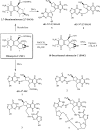Comparative Error-Free and Error-Prone Translesion Synthesis of N(2)-2'-Deoxyguanosine Adducts Formed by Mitomycin C and Its Metabolite, 2,7-Diaminomitosene, in Human Cells
- PMID: 27082015
- PMCID: PMC4871107
- DOI: 10.1021/acs.chemrestox.6b00087
Comparative Error-Free and Error-Prone Translesion Synthesis of N(2)-2'-Deoxyguanosine Adducts Formed by Mitomycin C and Its Metabolite, 2,7-Diaminomitosene, in Human Cells
Abstract
Mitomycin C (MC) is a cytotoxic and mutagenic antitumor agent that alkylates DNA upon reductive activation. 2,7-Diaminomitosene (2,7-DAM) is a major metabolite of MC in tumor cells, which also alkylates DNA. MC forms seven DNA adducts, including monoadducts and inter- and intrastrand cross-links, whereas 2,7-DAM forms two monoadducts. Herein, the biological effects of the dG-N(2) adducts formed by MC and 2,7-DAM have been compared by constructing single-stranded plasmids containing these adducts and replicating them in human embryonic kidney 293T cells. Translesion synthesis (TLS) efficiencies of dG-N(2)-MC and dG-N(2)-2,7-DAM were 38 ± 3 and 27 ± 3%, respectively, compared to that of a control plasmid. This indicates that both adducts block DNA synthesis and that dG-N(2)-2,7-DAM is a stronger replication block than dG-N(2)-MC. TLS of each adducted construct was reduced upon siRNA knockdown of pol η, pol κ, or pol ζ. For both adducts, the most significant reduction occurred with knockdown of pol κ, which suggests that pol κ plays a major role in TLS of these dG-N(2) adducts. Analysis of the progeny showed that both adducts were mutagenic, and the mutation frequencies (MF) of dG-N(2)-MC and dG-N(2)-2,7-DAM were 18 ± 3 and 10 ± 1%, respectively. For both adducts, the major type of mutation was G → T transversions. Knockdown of pol η and pol ζ reduced the MF of dG-N(2)-MC and dG-N(2)-2,7-DAM, whereas knockdown of pol κ increased the MF of these adducts. This suggests that pol κ predominantly carries out error-free TLS, whereas pol η and pol ζ are involved in error-prone TLS. The largest reduction in MF by 78 and 80%, respectively, for dG-N(2)-MC and dG-N(2)-2,7-DAM constructs occurred when pol η, pol ζ, and Rev1 were simultaneously knocked down. This result strongly suggests that, unlike pol κ, these three TLS polymerases cooperatively perform the error-prone TLS of these adducts.
Conflict of interest statement
The authors declare no competing financial interest.
Figures



Similar articles
-
Translesion Synthesis of the N(2)-2'-Deoxyguanosine Adduct of the Dietary Mutagen IQ in Human Cells: Error-Free Replication by DNA Polymerase κ and Mutagenic Bypass by DNA Polymerases η, ζ, and Rev1.Chem Res Toxicol. 2016 Sep 19;29(9):1549-59. doi: 10.1021/acs.chemrestox.6b00221. Epub 2016 Aug 17. Chem Res Toxicol. 2016. PMID: 27490094 Free PMC article.
-
Mutational analysis of the C8-guanine adduct of the environmental carcinogen 3-nitrobenzanthrone in human cells: critical roles of DNA polymerases η and κ and Rev1 in error-prone translesion synthesis.Biochemistry. 2014 Aug 19;53(32):5323-31. doi: 10.1021/bi5007805. Epub 2014 Aug 6. Biochemistry. 2014. PMID: 25080294 Free PMC article.
-
DNA adduct of the mitomycin C metabolite 2,7-diaminomitosene is a nontoxic and nonmutagenic DNA lesion in vitro and in vivo.Chem Res Toxicol. 2005 Feb;18(2):213-23. doi: 10.1021/tx049813h. Chem Res Toxicol. 2005. PMID: 15720125
-
Error-Prone and Error-Free Translesion DNA Synthesis over Site-Specifically Created DNA Adducts of Aryl Hydrocarbons (3-Nitrobenzanthrone and 4-Aminobiphenyl).Toxicol Res. 2017 Oct;33(4):265-272. doi: 10.5487/TR.2017.33.4.265. Epub 2015 Oct 15. Toxicol Res. 2017. PMID: 29071010 Free PMC article. Review.
-
Chemistry and biology of DNA containing 1,N(2)-deoxyguanosine adducts of the alpha,beta-unsaturated aldehydes acrolein, crotonaldehyde, and 4-hydroxynonenal.Chem Res Toxicol. 2009 May;22(5):759-78. doi: 10.1021/tx9000489. Chem Res Toxicol. 2009. PMID: 19397281 Free PMC article. Review.
Cited by
-
Biological Evaluation of DNA Biomarkers in a Chemically Defined and Site-Specific Manner.Toxics. 2019 Jun 25;7(2):36. doi: 10.3390/toxics7020036. Toxics. 2019. PMID: 31242562 Free PMC article. Review.
-
Interdependent Sequence Selectivity and Diastereoselectivity in the Alkylation of DNA by Decarbamoylmitomycin C.Chemistry. 2018 Sep 6;24(50):13278-13289. doi: 10.1002/chem.201802038. Epub 2018 Aug 10. Chemistry. 2018. PMID: 29958326 Free PMC article.
-
Translesion Synthesis of 2'-Deoxyguanosine Lesions by Eukaryotic DNA Polymerases.Chem Res Toxicol. 2017 Jan 17;30(1):61-72. doi: 10.1021/acs.chemrestox.6b00285. Epub 2016 Nov 1. Chem Res Toxicol. 2017. PMID: 27760288 Free PMC article.
-
Translesion Synthesis of the N(2)-2'-Deoxyguanosine Adduct of the Dietary Mutagen IQ in Human Cells: Error-Free Replication by DNA Polymerase κ and Mutagenic Bypass by DNA Polymerases η, ζ, and Rev1.Chem Res Toxicol. 2016 Sep 19;29(9):1549-59. doi: 10.1021/acs.chemrestox.6b00221. Epub 2016 Aug 17. Chem Res Toxicol. 2016. PMID: 27490094 Free PMC article.
-
Mutagenicity of a Model DNA-Peptide Cross-Link in Human Cells: Roles of Translesion Synthesis DNA Polymerases.Chem Res Toxicol. 2017 Feb 20;30(2):669-677. doi: 10.1021/acs.chemrestox.6b00397. Epub 2016 Dec 21. Chem Res Toxicol. 2017. PMID: 27951635 Free PMC article.
References
-
- Hata T.; Hoshi T.; Kanamori K.; Matsumae A.; Sano Y.; Shima T.; Sugawara R. (1956) Mitomycin, a new antibiotic from Streptomyces. I. J. Antibiot. 9, 141–146. - PubMed
-
- Wakaki S.; Marumo H.; Tomioka K.; Shimizu G.; Kato E.; Kamada H.; Kudo S.; Fujimoto Y. (1958) Isolation of new fractions of antitumor mitomycins. Antibiot. Chemother. 8, 228–240. - PubMed
Publication types
MeSH terms
Substances
Grants and funding
LinkOut - more resources
Full Text Sources
Other Literature Sources

